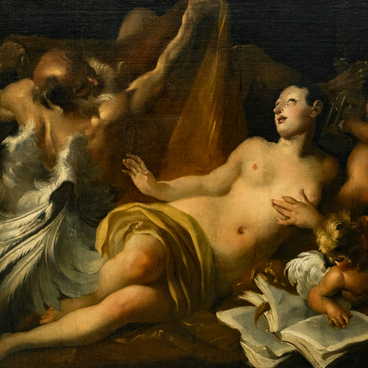The portrait of Infanta Isabella Clara Eugenia, Archduchess of Austria and Governess of Flanders, was accepted into the permanent museum exhibition as part of professor Gabyshev’s collection. The artwork was attributed as a female portrait from the Rubens workshop. The painting is paired with a portrait of Archduke Albrecht VII of Austria, Stadtholder of the Spanish Netherlands.
The composition of the portraits replicates the images of the rulers of the southern Netherlands from the Museum of Art History in Vienna by Peter Paul Rubens, executed by the famous painter in 1609 and 1610. In the same costumes and in the same poses, the couple is depicted in the painting “The Visit of Archduke Albert and Archduchess Isabella to the Cornelis van der Geest Art Gallery in 1615” by Willem van Haecht. Cornelis was an Antwerp philanthropist, friend and patron of Rubens. Portraits of Albrecht and Isabella in the same attire with accessories and poses, painted by Rubens in 1615, are featured in the National Gallery of London as well. The latter portraits are closest to the ones from the museum’s collection, but it should be noted that their painting style differs from the portraits by Rubens.
Isabella is depicted seated on a chair with a high red back. She wears a lavish gown entirely embroidered with gold, with a large round collar around her neck and lace ruffled cuffs. On her lap rests a white satin handkerchief and a fan. The color scheme is based on a gradation of grayish-pearl, brown and gold (the infanta’s dress) accents. The painting style is dense, with bluish shadows appearing in the color of the face and hands. The language of the fan, an essential accessory of the Spanish costume, can also say a lot: it is held in the right hand and is open, which indicates openness and willingness to listen.
After Albrecht’s death, Isabella ceased wearing
secular attire and adornments, opting instead to wear the monastic attire of
the Franciscan female order of Poor Clares until her own death. The presence of
similar images of Isabella in different museums indicates that the portraits
could be used as diplomatic gifts, given as a sign of favor, symbols of
trusting relationships, and so on. Apparently, the portrait was replicated in
different versions by both the master himself and the students of his workshop.
The Yakutsk copy of the portrait, given its quality, probably belongs to these
numerous replicas.


